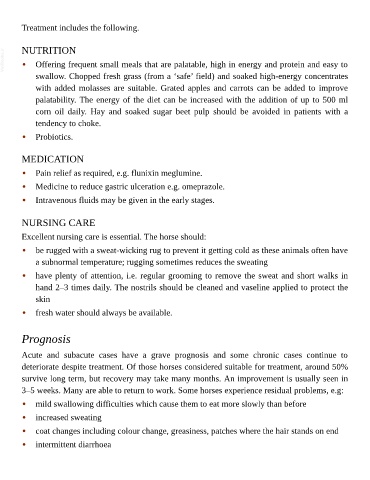Page 510 - The Veterinary Care of the Horse
P. 510
Treatment includes the following.
VetBooks.ir NUTRITION
•
Offering frequent small meals that are palatable, high in energy and protein and easy to
swallow. Chopped fresh grass (from a ‘safe’ field) and soaked high-energy concentrates
with added molasses are suitable. Grated apples and carrots can be added to improve
palatability. The energy of the diet can be increased with the addition of up to 500 ml
corn oil daily. Hay and soaked sugar beet pulp should be avoided in patients with a
tendency to choke.
• Probiotics.
MEDICATION
• Pain relief as required, e.g. flunixin meglumine.
• Medicine to reduce gastric ulceration e.g. omeprazole.
• Intravenous fluids may be given in the early stages.
NURSING CARE
Excellent nursing care is essential. The horse should:
• be rugged with a sweat-wicking rug to prevent it getting cold as these animals often have
a subnormal temperature; rugging sometimes reduces the sweating
• have plenty of attention, i.e. regular grooming to remove the sweat and short walks in
hand 2–3 times daily. The nostrils should be cleaned and vaseline applied to protect the
skin
• fresh water should always be available.
Prognosis
Acute and subacute cases have a grave prognosis and some chronic cases continue to
deteriorate despite treatment. Of those horses considered suitable for treatment, around 50%
survive long term, but recovery may take many months. An improvement is usually seen in
3–5 weeks. Many are able to return to work. Some horses experience residual problems, e.g:
• mild swallowing difficulties which cause them to eat more slowly than before
• increased sweating
• coat changes including colour change, greasiness, patches where the hair stands on end
• intermittent diarrhoea

